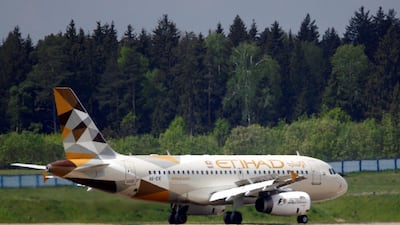Middle East airlines posted a strong rise in passenger demand in October, with numbers up 6.9 per cent from 3.9 per cent in September.
Capacity increased 5.3 per cent, and load factor climbed 1 percentage point to 69.6 per cent, according to the International Air Transport Association (Iata).
But demand to and from North America fell in year-on-year terms for the seventh consecutive month in September (the most recent month for which route-specific figures are available) and it remains the only international market not to have grown in annual terms this year. Traffic has been heavily affected by the now-lifted ban on portable electronic devices, as well as from the proposed travel bans to the US.
Globally, “demand for air travel remains strong as we head into the holiday travel season, and signs point to the broad-based economic upturn continuing into 2018, which is good news for demand for air travel”, said Alexandre de Juniac, Iata’s director general and chief executive.
Global passenger traffic results for October show demand (measured in revenue passenger kilometres, or RPKs) rose 7.2 per cent compared to the same month last year. Capacity grew 6.2 per cent and load factor climbed 0.8 percentage points to 80.8 per cent, which was a record for the month.
October’s performance was a strong bounce-back after the hurricane-related disruptions in September. Domestic and international travel growth largely was in balance.
“As expected, the recent severe weather in the Americas region had only a temporary impact on the healthy travel demand we have seen this year, and we remain on course for another year of above-trend growth,” said Mr de Juniac.
October international passenger demand rose 7.3 per cent compared to October 2016, which was an improvement compared to the 6.6 per cent demand increase for September. Airlines in all regions recorded growth. Total capacity climbed 6 per cent, and load factor increased 1 percentage point to 79.4 per cent.
Asia-Pacific airlines led all regions with traffic growth of 10.3 per cent compared to the year-ago period, which was up from an 8.7 per cent rise in September. Capacity climbed 8.4 per cent and load factor rose 1.3 percentage points to 78 per cent. Seasonally-adjusted passenger volumes are rising at an annualised rate of 8 to 9 per cent, supported by the solid regional economic backdrop and strong growth in the number of connections.
_____________
Read more:
Middle Eastern carriers post 4.6 per cent freight volume increase in October
Arab carriers hit out at US proposals to tax foreign airlines
_____________
European carriers’ October demand climbed 6.2 per cent over October 2016, which was a slowdown compared to the 7.2 per cent year-over-year growth recorded for September. Capacity increased 4.5 per cent and load factor rose 1.3 percentage points to 84.9 per cent, the highest among regions. While economic conditions have shown strong improvement over the past year or so, the upward trend in seasonally-adjusted traffic has slowed considerably since May, Iata said. This reflects the nature of international travel in the region, which is predominantly short-haul and hence, highly-price sensitive.
North American airlines’ traffic climbed 3.7 per cent in October compared to the year-ago period, lowest among the regions but an improvement compared to the hurricane-impacted 3 per cent growth in September.
Latin American airlines had an 8.7 per cent increase in traffic in October, which was a slowdown from September growth of 10.7 per cent, but still the second strongest percentage growth among regions. On a seasonally-adjusted basis, however, volumes are slightly below where they were three months ago. This may indicate spillover from the impact of Hurricanes Irma and Maria, according to Iata. Capacity climbed 9.1 per cent, and load factor slipped 0.3 percentage points to 82.6 per cent.
African airlines' traffic grew 7.5 per cent year-on-year in October, up from 3.6 per cent in September.
Domestic demand climbed 7.2 per cent in October compared to October 2016, while capacity rose 6.6 per cent. India and China continued to lead all markets, with double-digit growth rates.

